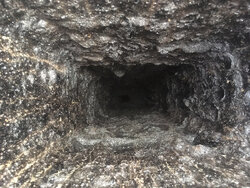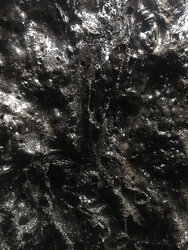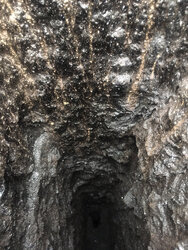Hi, I'm taking care of my father-in-laws house which is heated by a wood burning furnace. One morning I was having trouble getting the furnace started, and added a large chunk of cardboard and lit it on fire. The cardboard burned, and soon after I heard a WHOOSH like a jet engine coming from the chimney. Through a tiny crack where the metal pipe from the furnace attaches to the cinderblock chimney I could see flames inside the cinderblock chimney. My wife raced outside and saw black smoke billowing from the chimney. Thankfully, after closing the damper, the fire went out.
Later, after a couple scotches, I inspected the chimney base. There is a small metal door that I could open and look up the chimney as well as see into the metal pipe that connects to the furnace (on the left). Here is what I saw:
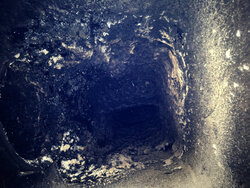
This stuff flakes off easily, but beneath it is a very shiny thin layer of black. I can't reach it tho so don't know if it is sticky or how thick it is.
Went up on the roof and looked down the chimney, this is what I saw:
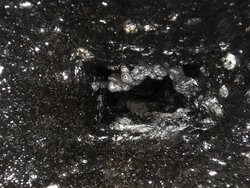
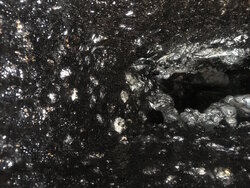
The black stuff pictured is shiny and sticky to the touch - it has the consistency of tar. It coats the masonry liner as far as I can see down. The coating is about 1-5mm thick thick (where it has not bubbled),
All I know about creosite I have learned researching online after this event. From what I've read I assume this is stage 3. So out of fear of starting another chimney fire we have have stopped using the wood furnace and are heating the house with electricity (it has both).
I'm not sure where to go from here, so I'm looking for opinions. I have found a variety of products that claim to break stage 3 down but I don't know if we're at a point where those would do any good? Do we need a pro? Any help greatly appreciated.
Later, after a couple scotches, I inspected the chimney base. There is a small metal door that I could open and look up the chimney as well as see into the metal pipe that connects to the furnace (on the left). Here is what I saw:

This stuff flakes off easily, but beneath it is a very shiny thin layer of black. I can't reach it tho so don't know if it is sticky or how thick it is.
Went up on the roof and looked down the chimney, this is what I saw:


The black stuff pictured is shiny and sticky to the touch - it has the consistency of tar. It coats the masonry liner as far as I can see down. The coating is about 1-5mm thick thick (where it has not bubbled),
All I know about creosite I have learned researching online after this event. From what I've read I assume this is stage 3. So out of fear of starting another chimney fire we have have stopped using the wood furnace and are heating the house with electricity (it has both).
I'm not sure where to go from here, so I'm looking for opinions. I have found a variety of products that claim to break stage 3 down but I don't know if we're at a point where those would do any good? Do we need a pro? Any help greatly appreciated.
Last edited by a moderator:




 Those pics ought to be pinned as examples.
Those pics ought to be pinned as examples.
